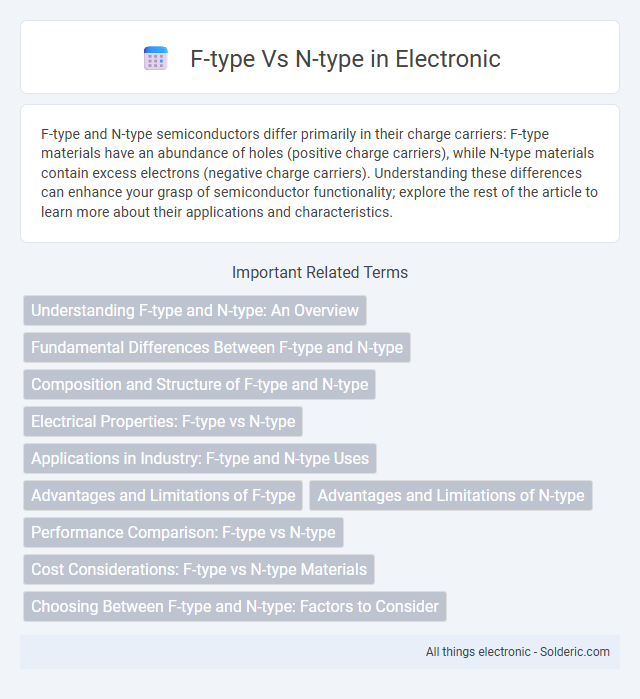F-type and N-type semiconductors differ primarily in their charge carriers: F-type materials have an abundance of holes (positive charge carriers), while N-type materials contain excess electrons (negative charge carriers). Understanding these differences can enhance your grasp of semiconductor functionality; explore the rest of the article to learn more about their applications and characteristics.
Comparison Table
| Feature | F-type | N-type |
|---|---|---|
| Definition | P-type semiconductor with positive charge carriers (holes) | N-type semiconductor with negative charge carriers (electrons) |
| Charge Carriers | Holes (positive) | Electrons (negative) |
| Dopants | Acceptors (e.g., Boron) | Donors (e.g., Phosphorus) |
| Electrical Conductivity | Moderate, due to holes | Higher, due to electrons |
| Majority Carriers | Holes | Electrons |
| Minority Carriers | Electrons | Holes |
| Applications | Positive side in diodes, transistors | Negative side in diodes, transistors |
Understanding F-type and N-type: An Overview
F-type and N-type refer to classifications of semiconductor materials based on their charge carriers: F-type semiconductors, often called P-type, have an abundance of holes (positive charge carriers), while N-type semiconductors have an excess of electrons (negative charge carriers). These electrical properties influence the behavior of semiconductor devices like diodes and transistors, where the junction between F-type and N-type regions forms the basis of electronic functionality. Understanding these fundamental differences helps you optimize electronic components for your specific application, improving device performance and efficiency.
Fundamental Differences Between F-type and N-type
F-type and N-type semiconductor materials differ fundamentally in their charge carrier types: F-type (or P-type) semiconductors contain an abundance of holes as positive charge carriers due to acceptor impurities, while N-type semiconductors possess excess electrons as negative charge carriers introduced by donor impurities. The doping process alters the electrical conductivity by creating majority carriers--holes in F-type and electrons in N-type--resulting in distinct electrical behaviors and applications in devices like diodes and transistors. Understanding the contrast in charge carrier dominance is crucial for designing and optimizing semiconductor components in electronic circuits.
Composition and Structure of F-type and N-type
F-type and N-type semiconductors differ primarily in their composition and crystal structure adjustments designed to alter electrical conductivity. F-type semiconductors are typically doped with elements that introduce extra positive charge carriers, or holes, by accepting electrons within the crystal lattice, enhancing p-type conductivity. N-type semiconductors incorporate donor impurities with additional electrons in their structure, supplying free electrons that increase negative charge carrier density and improve conductivity in your electronic devices.
Electrical Properties: F-type vs N-type
F-type and N-type semiconductors differ notably in their electrical properties due to the type of charge carriers dominating conductivity: F-type (p-type) materials have an abundance of holes acting as positive charge carriers, while N-type materials possess excess electrons serving as negative charge carriers. The resistivity of N-type semiconductors is generally lower than that of F-type because electrons have higher mobility compared to holes, enhancing conductivity. Understanding these differences in carrier concentration and mobility is crucial for optimizing your electronic device's performance and efficiency.
Applications in Industry: F-type and N-type Uses
F-type and N-type semiconductors play crucial roles in electronic devices, with F-type (P-type) materials primarily used in diode and transistor manufacturing to control current flow through positive charge carriers (holes). N-type semiconductors, doped with elements providing extra electrons, are essential for creating efficient power devices, photovoltaic cells, and high-speed switching components in the industrial sector. Their complementary properties enable the construction of PN junctions fundamental to integrated circuits, sensors, and various electronic control systems in automotive and communication industries.
Advantages and Limitations of F-type
F-type semiconductors use fluorine as a dopant, enhancing electron mobility and reducing noise in electronic devices, which improves the overall performance of transistors and integrated circuits. This doping results in higher conductivity and better thermal stability compared to some alternatives but may involve more complex fabrication processes and higher costs. Your choice of F-type material can benefit high-speed and high-frequency applications, though limitations include potential compatibility issues with certain substrates.
Advantages and Limitations of N-type
N-type solar cells offer higher efficiency and greater resistance to light-induced degradation compared to F-type cells, making them ideal for long-term energy production. They exhibit better performance under low-light conditions and increased tolerance to temperature variations, enhancing your solar system's overall reliability. However, the manufacturing process is more complex and costly, which can limit widespread adoption despite these technical advantages.
Performance Comparison: F-type vs N-type
F-type transistors exhibit higher electron mobility, resulting in faster switching speeds and improved overall performance compared to N-type transistors, which benefit from better hole conduction in certain semiconductor applications. The efficiency of F-type devices often leads to lower power consumption and enhanced thermal stability under high-frequency operations. However, N-type transistors maintain advantages in fabrication simplicity and cost-effectiveness, making them preferable for specific circuit designs despite slightly lower performance metrics.
Cost Considerations: F-type vs N-type Materials
N-type solar panels typically have higher efficiency but come at a greater cost due to advanced fabrication processes and higher purity silicon requirements. F-type panels offer a more cost-effective solution with slightly lower efficiency, making them suitable for budget-conscious projects. Your choice depends on balancing upfront expenditure with long-term energy savings and performance needs.
Choosing Between F-type and N-type: Factors to Consider
Choosing between F-type and N-type materials depends on your specific application needs, such as electrical conductivity, doping concentration, and temperature stability. F-type semiconductors have electrons as majority carriers, offering high electron mobility, while N-type semiconductors use positively charged holes, which affect device performance differently. Your decision should consider factors like the type of electronic device, desired conductivity type, and cost-efficiency to optimize performance.
F-type vs N-type Infographic

 solderic.com
solderic.com